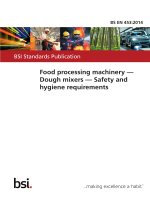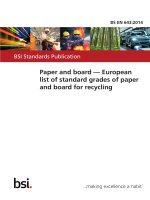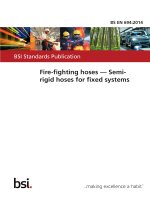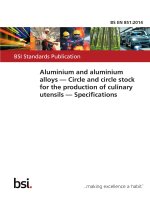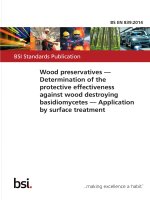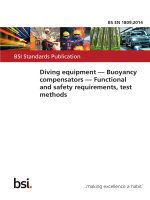Bsi bs en 62394 2014
Bạn đang xem bản rút gọn của tài liệu. Xem và tải ngay bản đầy đủ của tài liệu tại đây (3.13 MB, 248 trang )
BS EN 62394:2014
BSI Standards Publication
Service diagnostic interface
for consumer electronics
products and networks —
Implementation for echonet
BS EN 62394:2014 BRITISH STANDARD
National foreword
This British Standard is the UK implementation of EN 62394:2014. It is
identical to IEC 62394:2013.
The UK participation in its preparation was entrusted to Technical
Committee EPL/100, Audio, video and multimedia systems and equipment.
A list of organizations represented on this committee can be obtained on
request to its secretary.
This publication does not purport to include all the necessary provisions of
a contract. Users are responsible for its correct application.
© The British Standards Institution 2014.
Published by BSI Standards Limited 2014
ISBN 978 0 580 80395 6
ICS 33.160.99; 35.110
Compliance with a British Standard cannot confer immunity from
legal obligations.
This British Standard was published under the authority of the
Standards Policy and Strategy Committee on 31 January 2014.
Amendments/corrigenda issued since publication
Date Text affected
EUROPEAN STANDARD BS EN 62394:2014
NORME EUROPÉENNE
EUROPÄISCHE NORM EN 62394
ICS 33.160.99; 35.110 January 2014
English version
Service diagnostic interface for consumer
electronics products and networks -
Implementation for echonet
(IEC 62394:2013)
Interface de diagnostic de service pour Kundendienst-Diagnoseschnittstelle für
produits et réseaux électroniques grand Produkte und Netzwerke der
public - Implémentation pour echonet Unterhaltungselektronik - Implementierung
(CEI 62394:2013) für Echonet (IEC 62394:2013)
This European Standard was approved by CENELEC on 2013-10-31. CENELEC members are bound to comply
with the CEN/CENELEC Internal Regulations which stipulate the conditions for giving this European Standard
the status of a national standard without any alteration.
Up-to-date lists and bibliographical references concerning such national standards may be obtained on
application to the CEN-CENELEC Management Centre or to any CENELEC member.
This European Standard exists in three official versions (English, French, German). A version in any other
language made by translation under the responsibility of a CENELEC member into its own language and notified
to the CEN-CENELEC Management Centre has the same status as the official versions.
CENELEC members are the national electrotechnical committees of Austria, Belgium, Bulgaria, Croatia, Cyprus,
the Czech Republic, Denmark, Estonia, Finland, Former Yugoslav Republic of Macedonia, France, Germany,
Greece, Hungary, Iceland, Ireland, Italy, Latvia, Lithuania, Luxembourg, Malta, the Netherlands, Norway, Poland,
Portugal, Romania, Slovakia, Slovenia, Spain, Sweden, Switzerland, Turkey and the United Kingdom.
CENELEC European Committee for Electrotechnical Standardization
Comité Européen de Normalisation Electrotechnique
Europäisches Komitee für Elektrotechnische Normung
CEN-CENELEC Management Centre: Avenue Marnix 17, B - 1000 Brussels
© 2014 CENELEC - All rights of exploitation in any form and by any means reserved worldwide for CENELEC members.
Ref. No. EN 62394:2014 E
BS EN 62394:2014
EN 62394:2014 - 2 -
Foreword
The text of document 100/2182/FDIS, future edition 2 of IEC 62394, prepared by technical area 9: Audio,
video and multimedia applications for end-user network, of IEC technical committee 100: Audio, video
and multimedia systems and equipment was submitted to the IEC-CENELEC parallel vote and approved
by CENELEC as EN 62394:2014.
The following dates are fixed:
• latest date by which the document has (dop) 2014-07-31
to be implemented at national level by (dow) 2016-10-31
publication of an identical national
standard or by endorsement
• latest date by which the national
standards conflicting with the
document have to be withdrawn
Attention is drawn to the possibility that some of the elements of this document may be the subject of
patent rights. CENELEC [and/or CEN] shall not be held responsible for identifying any or all such patent
rights.
Endorsement notice
The text of the International Standard IEC 62394:2013 was approved by CENELEC as a European
Standard without any modification.
– 2 – BS EN 62394:2014
62394 © IEC:2013
CONTENTS
INTRODUCTION ..................................................................................................................... 9
1 Scope............................................................................................................................. 10
2 Normative references ..................................................................................................... 10
3 Terms, definitions and abbreviations ..............................................................................10
3.1 Terms and definitions ............................................................................................ 10
3.2 Abbreviations ........................................................................................................ 11
4 Different types of service diagnostics ............................................................................. 12
4.1 Stand-alone products ............................................................................................ 12
4.2 Facilities or household appliances network ............................................................12
4.3 Remote diagnosis.................................................................................................. 12
5 SDI requirements ........................................................................................................... 12
5.1 General ................................................................................................................. 12
5.2 Hardware .............................................................................................................. 12
5.3 Software................................................................................................................ 13
6 Tester software requirements ......................................................................................... 14
6.1 Reading the property diagnostic unit .....................................................................14
6.2 General information (product identification) ...........................................................14
6.3 Diagnosis information ............................................................................................ 14
7 Control protocol 1st ......................................................................................................... 14
7.1 General ................................................................................................................. 14
7.2 Frame format.........................................................................................................14
8 Control protocol 2nd ........................................................................................................ 42
8.1 General ................................................................................................................. 42
8.2 Frame format.........................................................................................................42
9 ECHONET objects: detailed specifications ..................................................................... 55
9.1 Basic concept........................................................................................................ 55
9.2 ECHONET properties: basic specifications ............................................................56
9.3 Device object super class specifications ................................................................58
9.4 Temperature sensor class specifications ...............................................................70
9.5 Humidity sensor class specifications .....................................................................70
9.6 Illuminance sensor class specifications .................................................................71
9.7 Human detection sensor class specifications .........................................................72
9.8 Electric energy sensor class specifications ............................................................73
9.9 Open/close sensor class specifications .................................................................74
9.10 Current value sensor class specifications ..............................................................76
9.11 Air speed sensor class specifications ....................................................................77
9.12 Water flow rate sensor class specifications ........................................................... 78
9.13 Home air conditioner class specifications ..............................................................79
9.14 Ventilation fan class specifications ........................................................................99
9.15 Air purifier class specifications ............................................................................ 100
9.16 Humidifier class specifications............................................................................. 101
9.17 Electrically operated shade class specifications .................................................. 104
9.18 Electric water heater class specifications ............................................................ 105
9.19 Household solar power generation class specifications ....................................... 111
BS EN 62394:2014 – 3 –
62394 © IEC:2013
9.20 Floor heater class specifications.......................................................................... 113
9.21 Fuel cell class specifications ............................................................................... 118
9.22 Storage battery class specifications..................................................................... 125
9.23 Electric vehicle charge-discharge system class specifications ............................. 133
9.24 Water flow meter class specifications .................................................................. 142
9.25 Power distribution board metering class specifications ........................................ 146
9.26 Smart electric meter class specifications ............................................................. 166
9.27 Smart gas meter class specifications ................................................................... 177
9.28 General light class specifications......................................................................... 184
9.29 Refrigerator class specifications .......................................................................... 187
9.30 Microwave oven class specifications ................................................................... 197
9.31 Washer and dryer class specifications ................................................................. 213
9.32 Clothes dryer class specifications........................................................................ 235
9.33 Cooking heater class specifications ..................................................................... 237
9.34 Switch class specifications .................................................................................. 243
10 Property map description format ................................................................................... 244
Bibliography........................................................................................................................ 245
Figure 1 – ECHONET frame for plain data format .................................................................15
Figure 2 – EHD detailed specifications..................................................................................16
Figure 3 – Configuration of SEA and DEA when an individual address is specified ...............17
Figure 4 – DEA (broadcast-stipulated) address configuration ................................................17
Figure 5 – Broadcast target stipulation code ......................................................................... 18
Figure 6 – Node group stipulation bit specifications ..............................................................18
Figure 7 – OHD detailed specifications .................................................................................19
Figure 8 – EOJ detailed specifications ..................................................................................19
Figure 9 – EPC detailed specifications ..................................................................................21
Figure 10 – ESV detailed specifications ................................................................................ 21
Figure 11 – EDATA configuration in property value write service ..........................................25
Figure 12 – EDATA configuration in property value read service ...........................................25
Figure 13 – EDATA configuration in property value notification service .................................26
Figure 14 – EDATA configuration in property value element-stipulated write service .............27
Figure 15 – EDATA configuration in property value element-stipulated read service .............28
Figure 16 – EDATA configuration in property value element-stipulated notification
service .................................................................................................................................. 29
Figure 17 – EDATA configuration in property value element-stipulated addition ....................30
Figure 18 – EDATA configuration in property value element-stipulated deletion ....................31
Figure 19 – EDATA configuration in property value element-stipulated existence
confirmation .......................................................................................................................... 32
Figure 20 – EDATA configuration in property value element addition ....................................33
Figure 21 – EDATA configuration in property value notification (response required)..............33
Figure 22 – EDATA configuration in property value element-stipulated notification
(response required) .............................................................................................................. 34
Figure 23 – CpESV configuration .......................................................................................... 35
Figure 24 – Relationship between write request (requiring no response) and write
"process-not-possible" response ........................................................................................... 38
– 4 – BS EN 62394:2014
62394 © IEC:2013
Figure 25 – Relationship between write request (requiring a response), write "accepted"
response, and write "process-not-possible" response............................................................39
Figure 26 – Relationship between read request (requiring a response), read "accepted"
response, and read "process-not-possible" response ............................................................40
Figure 27 – Notification message format ...............................................................................41
Figure 28 – Relationship between property value notification (requiring a response) and
property value notification response......................................................................................41
Figure 29 – Processing target property counter for three requests ........................................42
Figure 30 – Property data counter.........................................................................................42
Figure 31 – ECHONET Lite frame format ..............................................................................43
Figure 32 – Detailed specifications of ELHD1 ....................................................................... 43
Figure 33 – Detailed specifications of ELHD2 ....................................................................... 44
Figure 34 – Detailed specifications of EOJ code ...................................................................44
Figure 35 – ELSV code detailed specifications......................................................................45
Figure 36 – ELDATA configuration for property value write service
(no response required).......................................................................................................... 48
Figure 37 – ELDATA configuration for property value write service (response required)........49
Figure 38 – ELDATA configuration for property value read service........................................50
Figure 39 – ELDATA configuration for property value write and read service ........................51
Figure 40 – ELDATA configuration for property value notification service..............................52
Figure 41 – ELDATA configuration for property value notification (response required)
service .................................................................................................................................. 53
Figure 42 – EPC detailed specifications ................................................................................ 54
Figure 43 – ECHONET Lite Property data counter ................................................................55
Figure 44 – Example of array elements .................................................................................57
Figure 45 – Example of property value element deletion .......................................................58
Figure 46 – Example of property value element addition .......................................................58
Figure 47 – Data structure of “identification number” property ...............................................64
Figure 48 – Data structure of “manufacturer’s fault code” property ........................................65
Figure 49 – Air flow direction (vertical) setting ...................................................................... 90
Figure 50 – Air flow direction (horizontal) setting ..................................................................91
Figure 51 – Mounted air cleaning method .............................................................................93
Figure 52 – Air purifier function setting .................................................................................94
Figure 53 – Air refresh method.............................................................................................. 94
Figure 54 – Air refresher function setting .............................................................................. 95
Figure 55 – Self-cleaning method.......................................................................................... 95
Figure 56 – Self-cleaning function setting ............................................................................. 96
Figure 57 – Implemented ion emission method ................................................................... 104
Figure 58 – Daily timer setting ............................................................................................ 117
Figure 59 – Stove ............................................................................................................... 240
Table 1 – Bit pattern for hop count ........................................................................................ 16
Table 2 – List of class group codes ....................................................................................... 20
Table 3 – List of ESV codes for requests .............................................................................. 23
Table 4 – List of ESV codes for response/notification............................................................23
BS EN 62394:2014 – 5 –
62394 © IEC:2013
Table 5 – List of ESV codes for “response-not-possible” responses ......................................24
Table 6 – List of CpESV codes for request/notification ..........................................................36
Table 7 – List of CpESV codes for "accepted" response .......................................................37
Table 8 – List of CpESV codes for "process-not-possible" response .....................................37
Table 9 – List of class group codes ....................................................................................... 45
Table 10 – List of service codes for request .......................................................................... 47
Table 11 – List of ELSV codes for response/notification........................................................47
Table 12 – List of ELSV codes for “response not possible”....................................................48
Table 13 – EPC code allocation table ................................................................................... 54
Table 14 – Data types, data sizes, and overflow/underflow codes .........................................57
Table 15 – List of device object super class configuration properties ....................................59
Table 16 – Installation location (space) types and the bit values assigned to them................63
Table 17 – Fault-content property value assignments ...........................................................67
Table 18 – List of temperature sensor properties ..................................................................70
Table 19 – List of humidity sensor properties ........................................................................71
Table 20 – List of illuminance sensor properties....................................................................71
Table 21 – List of human detection sensor properties ...........................................................72
Table 22 – List of electric energy sensor properties ..............................................................73
Table 23 – List of open/close sensor properties ....................................................................75
Table 24 – List of current value sensor properties .................................................................76
Table 25 – List of air speed sensor properties.......................................................................77
Table 26 – List of water flow rate sensor properties ..............................................................78
Table 27 – List of home air conditioner properties .................................................................79
Table 28 – Air flow direction (horizontal) setting....................................................................91
Table 29 – List of ventilation fan properties...........................................................................99
Table 30 – List of air purifier properties............................................................................... 100
Table 31 – List of humidifier properties ............................................................................... 102
Table 32 – List of electrically operated shade properties ..................................................... 105
Table 33 – List of electric water heater properties ............................................................... 106
Table 34 – List of household solar power generation properties .......................................... 111
Table 35 – List of floor heater properties............................................................................. 114
Table 36 – List of fuel cell properties .................................................................................. 119
Table 37 – List of storage battery properties ....................................................................... 126
Table 38 – List of electric vehicle charge-discharge system properties................................ 133
Table 39 – List of water flow meter properties ..................................................................... 142
Table 40 – List of power distribution board metering properties........................................... 146
Table 41 – List of smart electric meter properties................................................................ 167
Table 42 – List of smart gas meter properties ..................................................................... 177
Table 43 – Security data information property ..................................................................... 182
Table 44 – gas consumption log information property ......................................................... 184
Table 45 – List of general light properties ........................................................................... 184
Table 46 – List of refrigerator properties ............................................................................. 187
Table 47 – List of microwave oven properties ..................................................................... 198
– 6 – BS EN 62394:2014
62394 © IEC:2013
Table 48 – Heating status property ..................................................................................... 204
Table 49 – Automatic heating setting property .................................................................... 205
Table 50 – Automatic heating cycle codes .......................................................................... 206
Table 51 – Prompt message codes ..................................................................................... 210
Table 52 – 2 bytes bitmap definition for each accessory ..................................................... 211
Table 53 – List of washer and dryer properties.................................................................... 213
Table 54 – washer and dryer setting property ..................................................................... 219
Table 55 – washer and dryer cycle option list 1 property ..................................................... 225
Table 56 – Washer and dryer cycle option list 2 property .................................................... 225
Table 57 – Washer and dryer cycle option list 3 property .................................................... 226
Table 58 – Current stage of washer and dryer cycle property.............................................. 229
Table 59 – List of clothes dryer properties .......................................................................... 236
Table 60 – List of cooking heater properties........................................................................ 238
Table 61 – List of switch properties..................................................................................... 243
Table 62 – Property map description format ........................................................................ 244
BS EN 62394:2014 – 9 –
62394 © IEC:2013
INTRODUCTION
Consumer products are often repaired by service workshops, which service a wide range of
products developed by different manufacturers.
For highly complex products, fault diagnosis becomes increasingly difficult and time consuming.
To facilitate diagnosis, manufacturers often develop built-in diagnostic software that
communicates with an external diagnostic unit through a service diagnostic interface (SDI).
To avoid the need for a service workshop to purchase several different diagnostic units from
different manufacturers for different products, a standardized SDI is proposed for use by all
manufacturers of any products requiring a diagnostic interface. The result will be that only one
SDI is needed in the service workshops.
The SDI should be suitable for diagnosis in a facilities or household appliances network in which
different products from different manufacturers are connected together. The interface should
also allow for future development.
The standard SDI should
– be usable in future products,
– be easily connectable to a product or a network,
– be inexpensive,
– not limit product design.
– 10 – BS EN 62394:2014
62394 © IEC:2013
SERVICE DIAGNOSTIC INTERFACE FOR CONSUMER
ELECTRONICS PRODUCTS AND NETWORKS –
IMPLEMENTATION FOR ECHONET
1 Scope
This International Standard specifies requirements for service diagnostic software to be
implemented in products that incorporate a digital interface. It does not specify requirements for
carrying out remote diagnosis or for manufacturer-dependent software.
The SDI (Service Diagnostic Interface) requires an external controller (exclusive or
general-purpose/PC) into which service diagnostic software can be loaded. Part of the controller
software should be standardized while another part of this controller software should be unique
to the manufacturer.
To reach a common approach in servicing all products from all manufacturers, it is necessary to
standardize specific items to be tested in products and in controllers’ diagnostic software.
The SDI is based upon the ECHONET specification version 2.11, ECHONET Lite specification
version 1.01 and APPENDIX Detailed Requirements for ECHONET Device objects Release B
because this interface will be used in future products. The use of this connection and existing
communication protocols enable implementation in products at low cost, with maximum
flexibility and efficiency.
The SDI consists of
• specific hardware and software requirements of the device under test (DUT);
• specific requirements of the controller:
– the service software;
– an ECHONET interface;
• the connection between the controller and the DUT.
This standard provides the minimal requirements necessary to carry out computerized diagnosis.
It covers the standardized software of the controller as well as the standardized software and
provisions in the DUT.
2 Normative references
The following documents, in whole or in part, are normatively referenced in this document and
are indispensable for its application. For dated references, only the edition cited applies. For
undated references, the latest edition of the referenced document (including any amendments)
applies.
(void)
3 Terms, definitions and abbreviations
3.1 Terms and definitions
For the purposes of this document, the following terms and definitions apply.
BS EN 62394:2014 – 11 –
62394 © IEC:2013
3.1.1
ECHONET specifications
specifications designed to enable the use of various kinds of transmission media (for example,
power line, low-power radiofrequency, ETHERNET, Bluetooth®1
3.1.2
remote diagnosis
diagnosis of a product via telephone, Internet, etc.
3.2 Abbreviations
CpESV Compound ECHONET service
DEA Destination ECHONET address
DEOJ Destination ECHONET object
DUT Device under test
EBC ECHONET byte counter
EDATA ECHONET DATA
EDT ECHONET property value data
EHD ECHONET headers
ELDATA ECHONET Lite DATA
ELHD ECHONET Lite headers
ELPDC ECHONET Lite Property data counter
ELSV ECHONET Lite service
EOJ ECHONET objects
EPC ECHONET property
ESV ECHONET service
EVPS Electric Vehicle Power System
LSB Least Significant Bit
MSB Most Significant Bit
OEM Original equipment manufacturer
OHD Object message header
OPC Processing target property counter
PC Personal computer
PDC Property data counter
PEDATA Plane EDATA (Plane ECHONET data)
ROM Read-only memory
SDI Service diagnostic interface
SEA Source ECHONET address
SEOJ Source ECHONET object
SOC State of Charge
TID Transaction ID
V2H Vehicle to Home
____________
1 ETHERNET is the trademark of a product supplied by Xerox Corporation.
Bluetooth is the trademark of a product supplied by Bluetooth SIG, Inc.
This information is given for the convenience of users of this standard and does not constitute an endorsement by
IEC of the product named. Equivalent products may be used if they can be shown to lead to the same results.
– 12 – BS EN 62394:2014
62394 © IEC:2013
4 Different types of service diagnostics
4.1 Stand-alone products
For stand-alone products, a connection is made between the diagnostic controller and the DUT,
where the DUT is from any manufacturer and of any type.
4.2 Facilities or household appliances network
In a facilities or household appliances network, a connection is made between the diagnostic
controller and a network of facilities or household appliances. Several different facilities or
household appliances are interconnected and not all of them are necessarily from the same
manufacturer.
In this case, the SDI shall list the products on the network, detect which facilities or appliances
are causing problem, and diagnose the product concerned.
4.3 Remote diagnosis
In addition to the configurations described in 4.1 and 4.2, a link can be made (for example, via
telephone, the Internet, etc.) between the diagnostic controller in the workshop and a
DUT/network at the customer’s home. Therefore, if a product has both an ECHONET interface
and a remote connection capability, this product should be able to transfer the diagnostic data,
as described in this standard, through the remote connection.
5 SDI requirements
5.1 General
The SDI consists of
• hardware and software, both in the DUT and in the test equipment (“tester”);
• the connection between the tester and the DUT.
The total SDI can be divided into the parts described in 5.2 and 5.3.
5.2 Hardware
5.2.1 Tester hardware
The hardware used for testing shall be a controller exclusive computer or general-purpose
controller (for example, desktop or laptop PC) provided with at least one suitable network
interface which enables the transfer of the ECHONET frame, as specified in 7.2, and running the
necessary diagnostic software.
NOTE The minimum requirements for the tester hardware depend on the respective tester platform.
5.2.2 Facilities or household appliances network
For the connection between the tester and the DUT, the “facilities or household appliances
network” shall be used. For the diagnosis of the DUT using the network, the tester shall be
connected to the facilities or household appliances network that conforms to the requirements of
7.1.
BS EN 62394:2014 – 13 –
62394 © IEC:2013
5.2.3 DUT hardware
5.2.3.1 General
The DUT shall be provided with at least one network interface which enables the transfer of the
ECHONET frame as specified in 7.2.
5.2.3.2 Facilities or household appliances network
For diagnosis on a network, the tester shall, where possible, be connected to a “facilities or
household appliances network” that conforms to the requirements of 7.1.
5.3 Software
5.3.1 General
The software for the SDI can be divided into two parts (tester and DUT) of which each part again
can be divided into mandatory (SDI common) software and non-mandatory
(manufacturer-dependent) software.
5.3.2 Tester software
The software platform of the tester shall be able to handle the ECHONET frame as specified in
7.2.
The SDI common software on the tester shall have the following functionalities:
a) initiate a service of “property value read request”, as specified in 7.2.9;
b) read out the service of “property value read response” and “property value notification” of all
products, as specified in 7.2.9;
c) display a list of all products connected to the facilities or household appliances network to
which the tester is connected. On the display shall be listed the
– manufacturer code property,
– place-of-business code property,
– product code property,
– serial number property,
– date-of-manufacture property;
d) display an indication of the fault status property which describes the occurrence of an error
in an actual device. The property code used as a property value is 0 × 41 when an error
exists or 0 × 42 when no error exists and is found to be “OK” or “Not OK” as specified in 9.3.6;
e) display an indication of the fault content property which describes the content of an error in
an actual device as specified in 9.3.6.
5.3.3 DUT software requirements for the SDI
The DUT shall be able to handle the ECHONET frame as specified in 7.2.
In addition, the SDI common software in the DUT shall be able to
a) run a self-test routine;
b) receive a service of “property value read request” as specified in 7.2.9 which is initiated by
the tester and response a service of “property value read response” as specified in 7.2.9;
c) initiate a service of “property value notification” as specified in 7.2.9.
– 14 – BS EN 62394:2014
62394 © IEC:2013
6 Tester software requirements
6.1 Reading the property diagnostic unit
The common application shall be able to retrieve from the SDI-compliant devices and display the
information specified in 6.1 to 6.3.
6.2 General information (product identification)
The manufacturer code property, the place-of-business code property, the product code
property and the serial number property shall be read from the DUT and displayed. These
property data shall always be available as specified in 9.30. The tester shall display this
information for all devices in the system.
NOTE The manufacturer code displayed might not be the same as the name on the physical device.
6.3 Diagnosis information
After start-up of the general information software, the diagnosis information shall be displayed.
7 Control protocol 1st
7.1 General
The ECHONET specifications were designed to enable the use of various kinds of transmission
media (for example, power line, low-power radiofrequency, ETHERNET, Bluetooth®). Slow
transmission speeds discourage large data transfers, and it is desirable to reduce the mounting
load on simple devices. In the light of this situation, ECHONET specifies the frame format for the
ECHONET communication middleware block to minimize the message size while fulfilling the
requirements of the communications layer structure.
7.2 Frame format
7.2.1 General
Figure 1 shows the content of the ECHONET communication middleware frame format. In the
ECHONET communication middleware specifications, messages exchanged between
ECHONET communications processing blocks are called ECHONET frames. ECHONET frames
are roughly divided into two types depending on the specified EHD: the secure message format,
of which the EDATA section is enciphered, and the plain message format, of which the EDATA
section is not enciphered. The secure message format and the plain message format are
subdivided into three formats depending on the specified EHD (see Table 3). Therefore, the
following six different message formats are available for ECHONET frames.
a) Plain basic message format
Insecure communication is performed so that one message is used to view or change the
contents of one property.
b) Plain compound message format
Insecure communication is performed so that one message is used to view or change the
contents of two or more properties.
c) Plain arbitrary message format
Insecure communication is performed so as to exchange information that complies with
vendor-unique specifications.
d) Secure basic message format
Secure communication is performed so that one message is used to view or change the
contents of one property.
e) Secure compound message format
Secure communication is performed so that one message is used to view or change the
contents of two or more properties.
BS EN 62394:2014 – 15 –
62394 © IEC:2013
f) Secure arbitrary message format
Secure communication is performed so as to exchange information that complies with
vendor-unique specifications.
Figure 1 shows the ECHONET frame structure for the plain message format.
Detailed specifications for each message component will be provided in the following
subclauses.
Format III (multiple property
simultaneous control form at
multiple property simultaneous
control format)
Format II (compound OHD SEOJ DEOJ ESV Cp OPC PDC ・・ PDC EPC EDT ・ ・・ EPC EDT
data format) ・
Size of Size of
Format I (basic data format) request request Request
1 n Request n
1
OHD : object message header (1B)
SEOJ : specifies source ECHONET Object (3B)
DEOJ : specifies destination ECHONET Object (3B)
CpESV : compound ECHONET service (1B)
OPC : number of processed properties (1B)
PDC : property data counter (1B)
EPC : ECHONET property (1B)
EDT : property value data (max. 245 bytes)
OHD SEOJ DEOJ EPC ESV EDT
OHD : object message header (1B)
SEOJ
DEOJ : specifies source ECHONET Object (3B)
EPC
ESV : specifies destination ECHONET Object (3B)
EDT
: ECHONET property (1B)
: ECHONET service (1B)
: property value data (max. 247 bytes)
EHD SEA DEA EBC EDAT (ECHONET frame)
EHD : ECHONET message header (1B) IEC 1133/06
SEA : source ECHONET Address (2B)
DEA : destination ECHONET Address (2B)
EBC : EDATA area byte counter (1B)
EDATA : ECHONET data (max. 256 bytes)
Figure 1 – ECHONET frame for plain data format
7.2.2 ECHONET headers (EHD)]
This subclause provides detailed specifications for the ECHONET header (EHD) shown in
Figure 1 and Figure 2.
– 16 – BS EN 62394:2014
62394 © IEC:2013
b7 b6 b5 b4 b3 b2 b1 b0
1 ***##☆ ☆
EDATA/PEDATA configuration specification
b1:b0=0:0 Message format I (basic message format)
0:1 Message format II (compound message format)
1:0 Message format III (arbitrary message format)
1:1 Reserved for future use
Secure message specification
0: plain message; 1: secure message
DEA code type specification (individual/broadcast)
0: Individual 1: Broadcast
Routing hop counter
Fixed IEC 1134/06
NOTE When b7=0, b0 to b6 will be specified separately (reserved for future use).
Figure 2 – EHD detailed specifications
The combination of b1 and b0 specifies the message format for EDATA/PEDATA. When b1:b0 =
0:0, it indicates Message Format I (basic message format), which allows one message to
operate on one property of one object. When b1:b0 = 0:1, it indicates Message Format II
(compound message format), which allows one message to operate on two or more properties of
one object. When b1:b0 = 1:0, it indicates Message Format III (arbitrary message format), of
which EDATA/PEDATA section is in an arbitrary format.
Bit b2 indicates whether the EDATA section is enciphered or not. When b2 = 1, it means that the
EDATA section is enciphered. When b2 = 0, it means that the EDATA section is not enciphered.
Bit b3 specifies whether the DEA (destination ECHONET address) shown in
Figure 3 and Figure 4 is a broadcast address or an individual address. When b3 = 1, this
indicates that a broadcast address is stipulated by the DEA code. When b3 = 0, this indicates
that an individual address is stipulated by the DEA code. Broadcast address codes are
discussed in 7.2.3.
Bits b4, b5, and b6 constitute a routing hop counter, which can be manipulated only by
ECHONET routers. When a message received at one subnet of an ECHONET router is
forwarded to another subnet, the counter is incremented. For every transmission from an
ordinary node, a hop count of 0 is used. The relationship between b4, b5, and b6 and the hop
count is shown in Table 1. The number of hops can be set to a value between 0 and 7.
Table 1 – Bit pattern for hop count
b6 b5 b4 Hop count
(router passes)
0 0 0 0
0 0 1 1
0 1 0 2
0 1 1 3
1 0 0 4
1 0 1 5
1 1 0 6
1 1 1 7
BS EN 62394:2014 – 17 –
62394 © IEC:2013
7.2.3 Source/Destination ECHONET address (SEA/DEA)
This subclause provides detailed specifications for the source ECHONET address (SEA) and
destination ECHONET address (DEA) shown in
Figure 3. Figure 4 shows the configuration of the source ECHONET address (SEA) and the
destination ECHONET address (DEA) prevailing when an individual address is stipulated by
setting b3 of EHD to 0.
1st byte 2nd byte
NetID (1 byte) NodeID (1 byte)
IEC 2431/13
Figure 3 – Configuration of SEA and DEA when an individual address is specified
When b3 of EHD is set to 1 to specify a broadcast, the destination ECHONET address (DEA)
becomes a code indicating a broadcast message for a specific ECHONET address group
(including a general broadcast). The DEA configuration in this case is shown in Figure 4. The
broadcast target stipulation code is shown in Figure 5 and Figure 6.
1st byte 2nd byte
NetID (1 byte) NodeID (1 byte)
IEC 2432/13
Broadcast type Broadcast target stipulation code Remarks
stipulation code
Specifies the node groups to be targeted for An intra-domain broadcast. In all subnets
0x00 a broadcast within all subnets. For node within a domain, a broadcast is sent to the
selection, see Figure 5. nodes stipulated by the broadcast target
0x01 stipulation code.
Specifies the node groups to be targeted for
0x02 a broadcast within its own subnet. For node An intra-own-subnet broadcast. In the own
0x03∼0x7F group selection, see Figure 5. subnet, a broadcast is sent to the nodes
0x80∼0xFF stipulated by the broadcast target
All nodes within the subnet having the Net stipulation code.
ID code stipulated by the "broadcast target
stipulation code" are targeted. A general broadcast within a specified
subnet. A broadcast is sent to all nodes
Reserved for future use. within the subnet stipulated by the
broadcast target stipulation code.
Open to user.
Used when a system manager will manage
the system in a collective housing unit or
small office building.
Figure 4 – DEA (broadcast-stipulated) address configuration
– 18 – BS EN 62394:2014
62394 © IEC:2013
b7 b6 b5 b4 b3 b2 b1 b0
☆☆☆ ☆☆☆☆☆
Broadcast to node group 0 YES/NO =1: YES
Broadcast to node group 1 YES/NO 0: NO
Broadcast to node group 2 YES/NO
Broadcast to node group 3 YES/NO IEC 1137/06
Broadcast to node group 4 YES/NO
Broadcast to node group 5 YES/NO
Broadcast to node group 6 YES/NO
Broadcast to node group 7 YES/NO
Figure 5 – Broadcast target stipulation code
0 8 4C2A6E1 9 5D3B7 F
0 Group 0
8
4 Group 1
C
2 Group 2
A
6 Group 3
E
1 Group 4
9
5 Group 5
D
3 Group 6
B
7 Group 7
F
IEC 1138/06
Figure 6 – Node group stipulation bit specifications
7.2.4 ECHONET byte counter (EBC)
EBC indicates the size of the ECHONET data region (EDATA region) shown in Figure 1. The size
is variable in 1-byte increments. The acceptable EDATA region size ranges from 6 to 256 bytes
(0x06 to 0xFF; 0x00 = 256). The lower limit is 6 bytes, which indicates that a message consists
of at least 6 bytes. The reason is that either the SEOJ or the DEOJ needs to be specified with the
EPC to ESV options specified for a plain message. A 6-byte message can be a message
requesting an ESV with the DEOJ specified or a message carrying a "response of processing
impossible" for ESV with the SEOJ specified.
7.2.5 ECHONET data (EDATA)
The DATA region for messages exchanged by the ECHONET communication middleware.
Maximum size: 256 bytes.
BS EN 62394:2014 – 19 –
62394 © IEC:2013
7.2.6 Object message header (OHD)
This subclause provides detailed specifications for the object message header (OHD) shown in
Figure 1. Detailed specifications are shown in Figure 7. The state in which b1 and b0 are both 0
will never occur.
b7 b6 b5 b4 b3 b2 b1 b0
1 0 0000☆ ☆
Source object stipulation 1:YES 0:NO
Source object stipulation 1:YES 0:NO
All “0” fixed
Fixed (reserved for future use) IEC 1139/06
NOTE When b6 and b7 have values other than b6 = 0 and b7 = 1, b0 to b5 will have different meanings.
The meanings of bits b0 to b5 when b6 and b7 have values other than b6 = 0 and b7 =1 will be stipulated in the future
(reserved for future use).
Figure 7 – OHD detailed specifications
7.2.7 ECHONET objects (EOJ)
This subclause provides detailed specifications for the source ECHONET object (SEOJ) code
and destination ECHONET object (DEOJ) code shown in Figure 1. Detailed specifications are
shown in Figure 8.
1st Byte 2nd Byte 3rd Byte
b7 b6 b5 b4 b3 b2 b1 b0 b7 b6 b5 b4 b3 b2 b1 b0 b7 b6 b5 b4 b3 b2 b1 b0
0####### ☆☆☆☆☆☆☆☆ ** ** * * **
X3: instance code
X2: class code
X1: class group code
0: fixed
IEC 1140/06
NOTE The meanings of the bits when b7 of the 1st byte is 1 will be stipulated in the future (reserved for future use).
Figure 8 – EOJ detailed specifications
ECHONET objects are described using the format [X1.X2] and [X3], with these formats to be
specified as shown below. (However, “.” is used only for descriptive purposes and does not
mean a specific code.) The object class is designated by the combination of X1 and X2, while X3
shows the class instance. A single ECHONET node may contain more than one instance of the
same class, in which case X3 is used to identify each one.
The specific items in Table 2 were specified on the basis of JEM 1439 (see Clause 10). Detailed
specifications for the objects shown here will be developed over time and, during this phase;
specifications for the objects themselves (i.e., present/not present) will be further reviewed.
The instance code 0x00 is regarded as a special code (code for specifying all instances). When
a DEOJ for which this code is specified is received, it is handled as a code specifying a
broadcast to all instances of a specified class.
